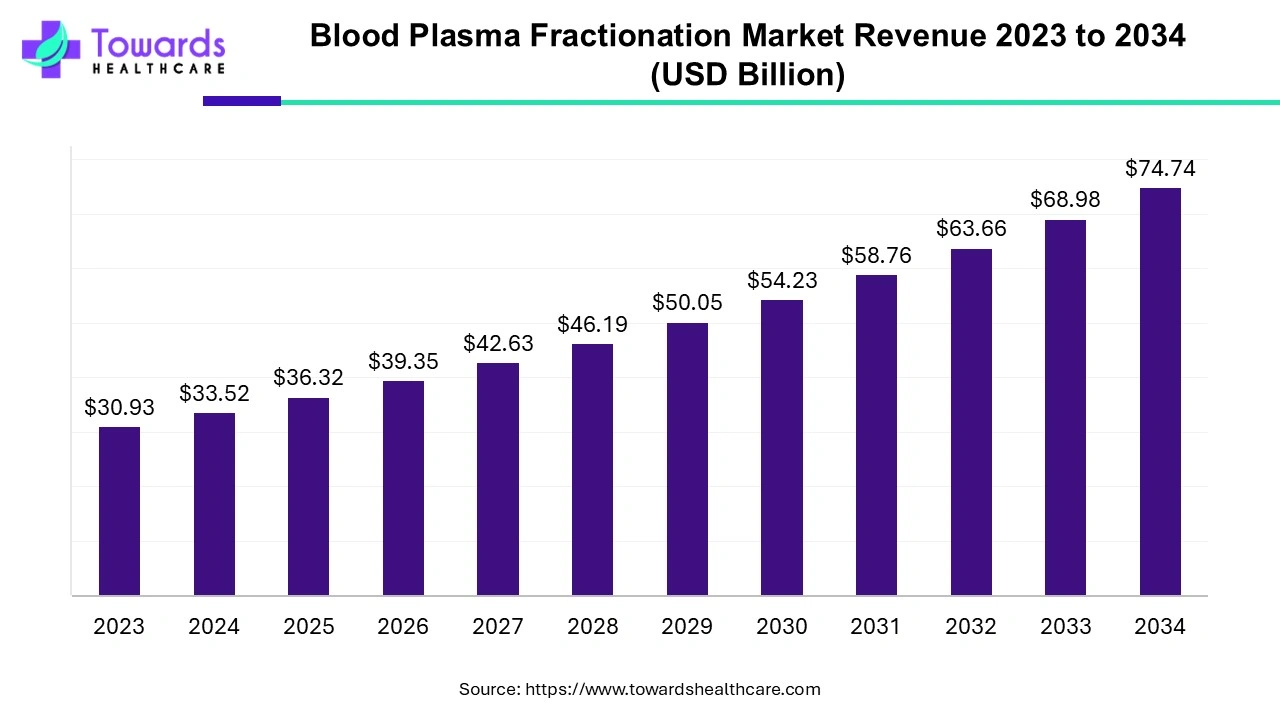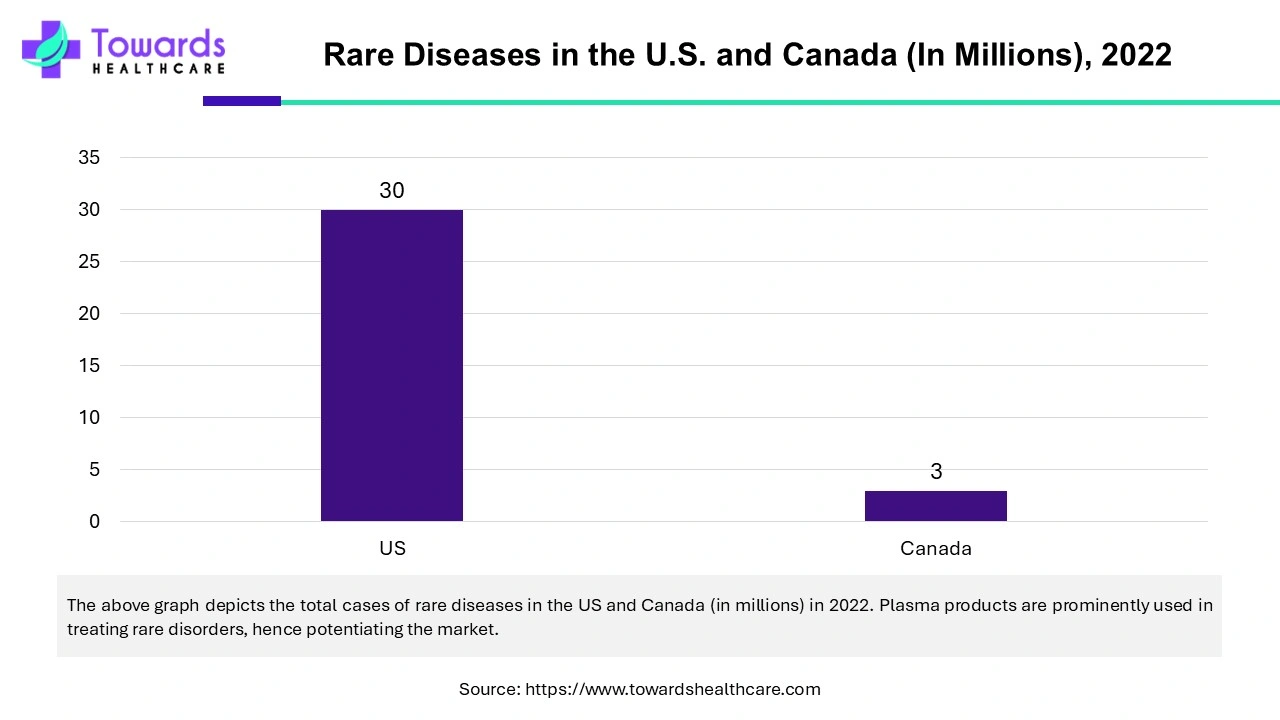February 2025

The blood plasma fractionation market was estimated at US$ 30.93 billion in 2023 and is projected to grow to US$ 74.74 billion by 2034, rising at a compound annual growth rate (CAGR) of 8.35% from 2024 to 2034. The rising incidences of immunological disorders and the prevalence of rare chronic disorders, increasing awareness about blood donations, and growing research and development drive the market.

Blood plasma is the liquid component of whole blood, comprising 55% of the total blood volume. Blood plasma fractionation is a process of isolating various components of plasma using different techniques. Plasma products contain coagulation factors such as factor VIII, factor IX, prothrombin complex, Von Willebrand factor, fibrinogen, immunoglobulins, protease inhibitors, anticoagulants, and albumin. These plasma products are used as therapeutics in the prevention, management, and treatment of life-threatening conditions like trauma, congenital deficiencies, immunologic disorders, or infections.
The rising incidences of immunological disorders, trauma, and blood disorders increase the demand for blood plasma. Albumin is used in trauma medicine, immunoglobulins are used in immunological disorders, coagulation factors are commonly used in blood clotting disorders such as hemophilia and Von Willebrand’s disease, and protease inhibitors are an effective treatment regimen for emphysema. Additionally, increasing blood donations and the increasing awareness of plasma products as therapeutics boost the market.
The rising demand for blood plasma products fosters innovation, leading to enhanced patient care and treatment. Several researchers are investigating novel fractionation techniques for isolating plasma components and also examining the role of plasma products as therapeutics in numerous disorders. Many low- and middle-income countries opt for small-scale fractionation processes due to a lack of large volumes of plasma. Traditionally, ethanol is used as a precipitation agent in blood plasma fractionation. However, removing ethanol can complete a small-scale fractionation process in single-use equipment for quick and efficient deployment. Another fractionation method is continuous manufacturing. This can reduce process and facility scale without compromising throughput capacity and economic efficiency. Furthermore, manufacturers are also looking to automate the fractionation process using advanced technologies. Automation in plasma fractionation can help in harvesting and cleaning operations.
The primary challenge faced by the market is the high upfront cost of equipment and products. The large-scale instruments required for the fractionation process require huge investments. Single-use filtration can cost up to $500/gram, while the selling price of plasma products can reach up to $150,000/gram, limiting the affordability of small-scale manufacturers. Another major challenge for the market is the availability of large volumes of plasma to cater to huge demands.
Rising Incidences of Rare Disorders Dominated North America
North America held a significant share of the blood plasma fractionation market in 2023. The advanced healthcare infrastructure, increasing investments & collaborations, favorable manufacturing infrastructure, and the presence of key players drive the market. According to the Red Cross Blood Donation Organization, around 6,500 units of plasma and 5,000 units of platelets are needed daily in the U.S. In Canada, 13% to 14% of the plasma used to make plasma protein products for Canadian patients comes from non-remunerated Canadian donors. The rising incidences of rare diseases increase the demand for plasma products. According to the WHO, each rare disease affects fewer than 200,000 Americans.

Increasing Awareness for Blood Donations Drives Asia-Pacific
Asia-Pacific is projected to host the fastest-growing blood plasma fractionation market in the coming years. The rising incidences of chronic disorders and rare disorders, growing research and development, increasing awareness about blood donations, and favorable government policies drive the market. Several government bodies conduct blood donation camps to increase awareness and promote blood donations in the region. Government bodies like the “Department of AIDS Control” by the Indian Government and the “Japan Blood Products Organization” by the Japanese Government regulate the use of blood and plasma components for treatment. In 2022, around 27.6 million units of blood were donated in China. Meanwhile, in India, around 33.8 per thousand people donated blood in 2022. Additionally, the increasing demand for albumin and immunoglobulin promotes the market.
By product, the immunoglobulins segment held a dominant presence in the blood plasma fractionation market in 2023 and is anticipated to witness significant growth during the forecast period. Immunoglobulins are the most widely used plasma product to treat several autoimmune, infectious, and inflammatory disorders. The rising incidences of autoimmune disorders are caused due to the COVID-19 pandemic.
By method, the centrifugation segment led the global market and is projected to expand rapidly in the coming years. Centrifugation is the most widely used technique to separate plasma from whole blood. It is the easiest and most cost-effective method for isolating plasma products.
By application, the neurology segment accounted for a considerable share of the blood plasma fractionation market in 2023. The rising incidences of neurological disorders and lack of efficient treatment potentiate the segment growth. In neurological disorders, therapeutic plasma exchange or plasmapheresis is the treatment of choice. According to the WHO, 1 in 3 people globally are suffering from neurological disorders.
By application, the oncology segment is predicted to grow with the highest CAGR in the market during the studied years. The rising incidences of cancer and growing research & development for the effective treatment of cancer boost the segment growth. Plasma exchange is widely preferred in hematological cancers. Low-temperature plasma therapy can target malignant cells to inhibit cell proliferation and tumor progression.
By end-use, the hospitals & clinics segment registered its dominance over the global blood plasma fractionation market in 2023 and is expected to grow at the fastest rate in the market during the forecast period. Hospitals & clinics have favorable infrastructure for storing plasma products and suitable regulatory standards. The increasing number of patients in hospitals & clinics also augments the segment growth.
By Product
By Method
By Application
By End-Use
By Region
February 2025
November 2024
December 2024
November 2024